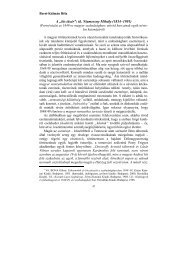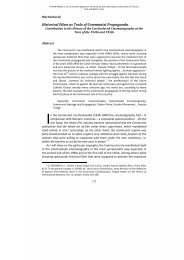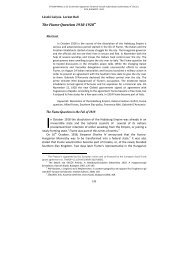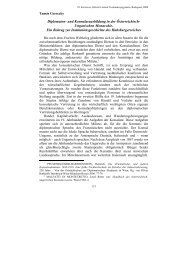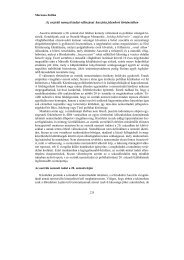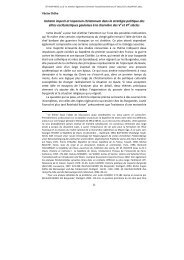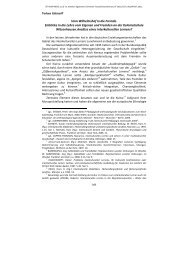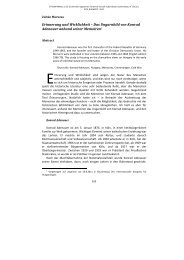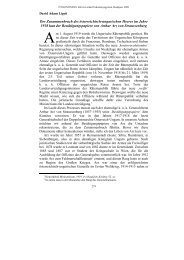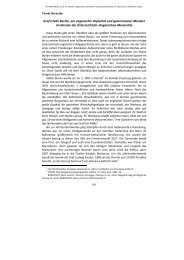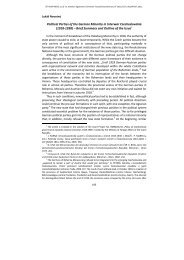The Molotov-Ribbentrop Pact - ELTE BTK Történelem Szakos Portál
The Molotov-Ribbentrop Pact - ELTE BTK Történelem Szakos Portál
The Molotov-Ribbentrop Pact - ELTE BTK Történelem Szakos Portál
You also want an ePaper? Increase the reach of your titles
YUMPU automatically turns print PDFs into web optimized ePapers that Google loves.
of Eichmann. For that Heydrich delivered a program, which had 4 aims: 68 1.<br />
Jews as soon as possible into cities and towns. 2. Jews from the Reich to<br />
Poland. 3. <strong>The</strong> remaining 30,000 Gypsies also to Poland. 4. Systematic<br />
transport of Jews from German territories in freight trains. 69<br />
On the 6 th of October 1939 Eichmann received the order from the leader of<br />
the office IV „Gegnerbekämpfung” („enemy combat”), which was part of the<br />
recently established Reichssicherheitshauptamt RSHA (Reich’s Security Main<br />
Office), to contact Gauleiter Wagner in Kattowitz. This meeting was about the<br />
deportation of about 70-80.000 Jews out of the district Kattowitz and the Jews<br />
out from the Czech-Polish border town Ostrava (Mährisch-Ostrau). Eichmann,<br />
who must have known about the plans of deportations since September 70 ,<br />
immediately began to act and travelled between Berlin, Vienna, Ostrava,<br />
Katowice and Galicia to prepare everything.<br />
Stahlecker thought, that the „Judenfrage” („Jewish Question”) in Vienna<br />
would also been „endgültig gelöst” („finally solved”) during those expulsions.<br />
Those expressions, as well as „restlose Lösung der Judenfrage” („complete<br />
solution of the Jewish question”) are already very similar to the later, at the SS<br />
common term of the „Endlösung” („Final Solution”). But according to Safrian<br />
those terms still meant a full expulsion and no genocide at this stage. 71<br />
On the 15 th of October 1939 Eichmann reported from Ostrava, that the<br />
railway station of Nisko at the San would be the aim of the deportations. In the<br />
implementations of the deportations, Eichmann was given full backing of his<br />
superiors and a very large scope of action. Due to the pressure and initiatives of<br />
Eichmann, the first transport with more than 900 men left Ostrava already on<br />
the 18 th of October 1939. Two days after, a train with 912 men from Vienna<br />
followed. Those men had to be provided from the Jewish Community just as<br />
construction equipment, which was needed for the construction of a camp.<br />
Arrived at Nisko, after a cruel five hour walk, craftsmen were assigned to the<br />
camp, but the majority were chased over the German-Soviet border line under<br />
the use of guns. <strong>The</strong>y were abandoned to their fate.<br />
„Test Run successful”<br />
<strong>The</strong> Nisko-Plan had barely begun, when the order came from above to stop<br />
the action. <strong>The</strong> removal of Jews were instructed to stop. 72 What were the<br />
reasons for the end? This question is answered in different ways.<br />
Burleigh lists the following causes: 1. <strong>The</strong> high transport capacity that was<br />
bound by it, that were needed by the Wehrmacht or for food shipments. 2.<br />
68 SAFRIAN, Hans: Eichmann’s Men. 48-49.<br />
69 Ibid. 49.<br />
70 Ibid. 51.<br />
71 Ibid. 52.<br />
72 Ibid. 56.<br />
89



